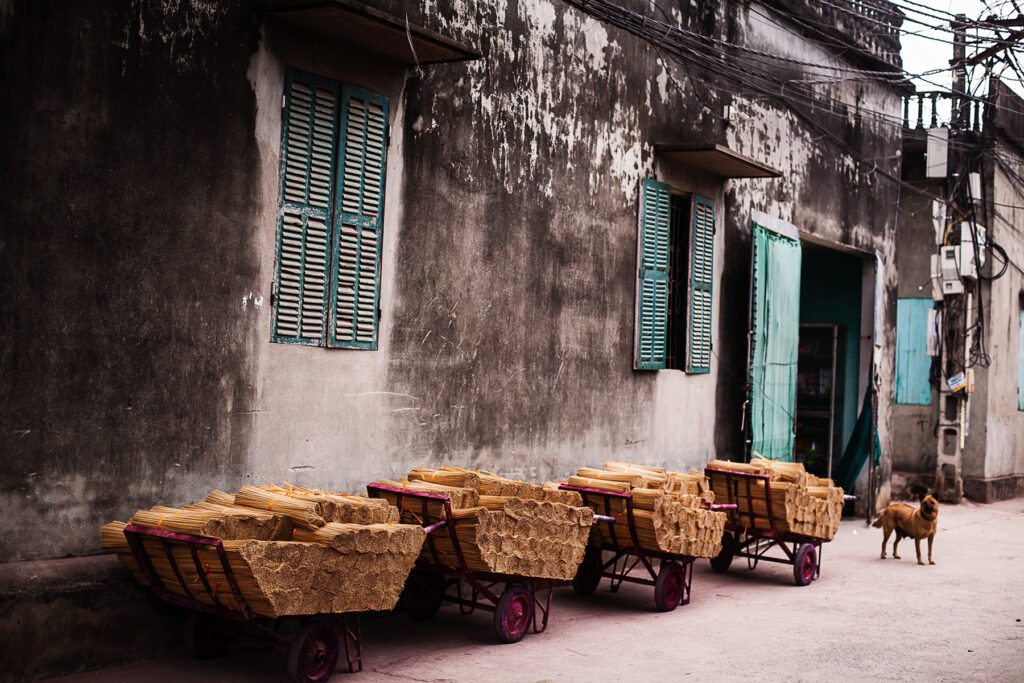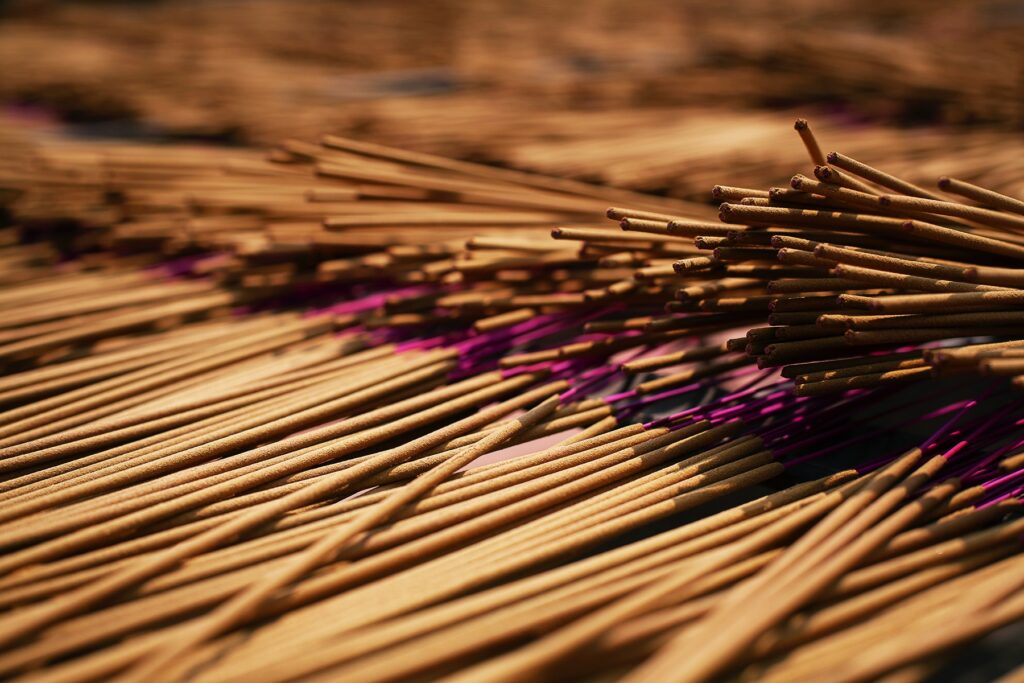I had the wonderful opportunity to visit the Quang Phu Cau incense village outside Hanoi, Vietnam on multiple occasions while work with VIETNAM In FOCUS photo tours during 2022 – 2023. Please enjoy some of my pictures taken during these visits.
Introduction to Quang Phu Cau Incense Village:

Nestled in the outskirts of Hanoi, Vietnam, lies a village that carries within its essence the ancient art of incense-making. Quang Phu Cau Incense Village, with its rich history and intricate crafting process, stands as a testament to the cultural heritage of the region.
All images on this page are copyright protected by ©LavonneBosman

In this blog post, we embark on a sensory journey, exploring the origins, the meticulous artistry, and the significance of incense production in this charming village. Many locals earn a living by contributing their share of work in the production line of making the incense.

The Genesis of Quang Phu Cau Incense:


The story of Quang Phu Cau Incense Village dates back centuries, to a time when incense was more than just a fragrance; it was a symbol of devotion and reverence. Inspired by their spiritual beliefs, the village’s artisans began crafting incense sticks by hand, laying the foundation for a tradition that continues to thrive to this day.

Quang Phu Cau Incense village unique color

Quang Phu Cau Incense Village, nestled in the heart of Vietnam, is renowned not only for its rich history of incense-making but also for the distinctive color that sets its incense apart. The incense sticks (before incense powder is added) produced here has become famous for its unique rich color that lies somewhere between vibrant red and deep saffron. This exceptional color is achieved through a meticulous dyeing process that involves using certain natural ingredients that are generally kept as a mysterious trade secret by its makers.

The Incense-Making Process:

1. Raw Materials: The art of incense-making is a delicate dance between nature and human hands. The sticks themselves are made through a lengthy process of refining bamboo from large pieces to perfectly fine. You might see various people in the village being involved in one or more of these steps of refinement and selection of the perfect sticks.

As for the incense powder, it begins with gathering high-quality raw materials, including natural fragrant woods, herbs, and essential oils. Key ingredients may include sandalwood, agarwood, cinnamon, and other aromatic plants, although usually you’ll find the recipes are kept secret.






2. Grinding and Mixing: The collected materials are skillfully ground into fine powders, releasing their fragrant aromas. These powders are then meticulously mixed to create a harmonious blend that will produce the desired fragrance when burned.

3. Binding the Incense: The prepared mixture is combined with a natural adhesive, usually derived from plants. Skilled artisans then roll this paste onto bamboo sticks, ensuring a consistent thickness and adherence.

4. Drying and Curing: The incense sticks are carefully laid out to dry naturally. This crucial step allows the incense to cure, developing its distinct aroma and ensuring its longevity.


5. Packaging: Once the incense sticks are fully cured, they are packaged with care, ready to be shared with the world.
Significance and Use of Quang Phu Cau Incense:
Quang Phu Cau incense holds deep spiritual and cultural significance for the Vietnamese people. It is widely used in religious ceremonies, temples, pagodas, and households. The aromatic smoke is believed to carry prayers and offerings to the divine, creating a bridge between the earthly and the spiritual realms.

Distribution and Beyond:

The aromatic creations of Quang Phu Cau Incense Village find their way to homes, places of worship, and markets across Vietnam and beyond. The village’s incense-making tradition not only supports local livelihoods but also contributes to the preservation of Vietnam’s cultural heritage.

Quang Phu Cau influx of tourism
In recent years, the serene haven of Quang Phu Cau Incense Village has witnessed a notable surge in tourism, bringing with it both opportunities and challenges. The influx of curious travelers and locals alike, seeking to delve into the village’s rich incense-making heritage has undoubtedly brought economic benefits to the local community. Traditional workshops have opened their doors to share their time-honored techniques, offering immersive experiences to eager visitors.

However, this rise in tourism has also sparked concerns about the potential disruption of the village’s tranquil ambiance and the delicate balance between preserving its authenticity and catering to the demands of modern-day visitors. As footfalls increase, local artisans find themselves striving to maintain the essence of their craft while adapting to the expectations of a broader audience.
Striking a harmonious equilibrium between the surge in interest and the preservation of the village’s cultural identity becomes a pivotal challenge that Quang Phu Cau now faces on its journey towards sustaining its timeless allure amidst the tides of tourism.
Conclusion:

Quang Phu Cau Incense Village stands as a living testament to the intricate art of incense-making. From its humble origins rooted in spirituality to its widespread use in daily life, the village’s legacy continues to thrive, infusing the air with not only fragrant aromas but also a profound connection to the past.
As we explore the village’s aromatic journey, we’re reminded that the essence of Quang Phu Cau transcends the tangible; it’s a story told through scent, a bridge between the seen and the unseen, the temporal and the eternal.
Invest in my Travel photography of Vietnam in my Etsy shop https://photoartstories.etsy.com
View more of my Vietnam travel photography here
You can also book your own photography tour to Quang Phu Cau incense village with Vietnam in Focus

Reply
You must be logged in to post a comment.